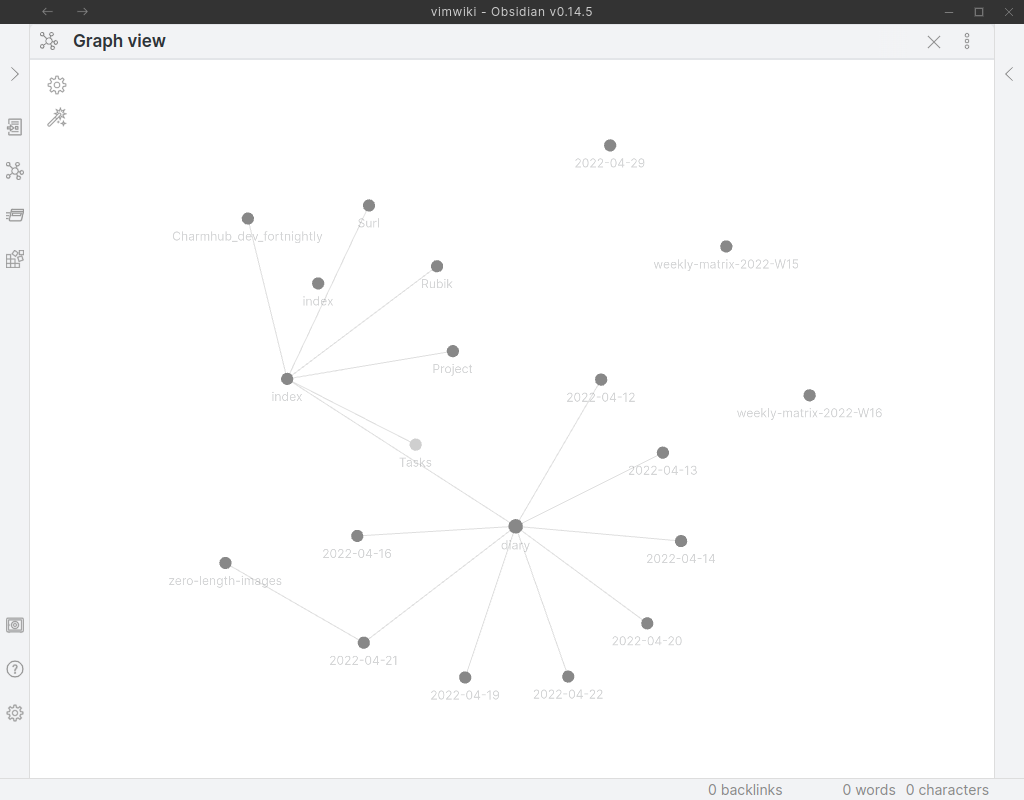Inspired by some article on the Internet, I set out to modernize the way I take daily notes. Up until now I had simply been dumping date-named files in a single directory. This allows me to use standard tools such as grep for finding stuff in my notes, also referencing them by date when appropriate, preparing notes in advance by creating the file for a date in the future, and have comfortable aliases/commands to do things.
For example, mn (make note) creates or opens the notes file for the current day, while wmatrix creates or opens a weekly file with progress updates from the team, which I use to keep track of daily standup items and follow up if necessary.
The random article in question talks about Obsidian and how it provides nice rendered Markdown notes with collapsible GUI controls, a ton of keyboard shortcuts, a modern and friendly graphical display, and it can render link relations in the notes to display a “knowledge graph”. It does all this on top of a local folder containing .md files, so it’s quite future-proof and portable, and provides mobile apps and some synchronization (which I haven’t explored) to keep notes updated.
I tried it and it felt quite heavyweight for a glorified note taker. I found the controls distracting, the general application not providing a ton of value over a single directory of files, and most importantly, the extensive keyboard navigability requires me learning another set of keybindings which at this point I’d really rather avoid.

The same random article, however, also pointed me in the direction of vimwiki. In essence, Obsidian’s knowledge base is a local wiki, and this is exactly what vimwiki provides - indeed, in the article they are identified as complementary to each other, with vimwiki providing editability and access via the command line, and Obsidian allowing remote access and a graphical view, when needed.
I configured vimwiki to use Markdown and store files next to my old notes folder:
let g:vimwiki_list = [{'path': '~/Documents/w/vimwiki',
\ 'syntax': 'markdown', 'ext': '.md'}]
The experience from vim is fantastic; \ww opens a wiki index, and from there any single word can become a link by hitting ENTER in command mode on top of it. Vimwiki automatically creates the target and you can start writing Markdown in it, which is nicely syntax-colored. Vimwiki automatically handles indenting and formatting of lists, tables and markdown headings, and nicely collapses and linkifies URLs. It can even manage to-do lists in brackets [ ] and indent/dedent hierarchical table entries.
Vimwiki also has the concept of “diary” entries which are automatically created under the current date’s name, as well as useful shortcuts for “yesterday” and “tomorrow” pages, and can auto-generate an index for all diary/dated entries.
Vimwiki has wiki-wide search functionality via :VWS, though of course one can still shell out and use grep in a directory of raw .md files for ultimate portability.
I updated my mn and wmatrix aliases to integrate with vimwiki and have been happily using it for the past few days. The experience is pretty close to what I had with my old raw notes folder with some niceties added on top; I’ll probably start leveraging them more as I get more familiar with the setup.